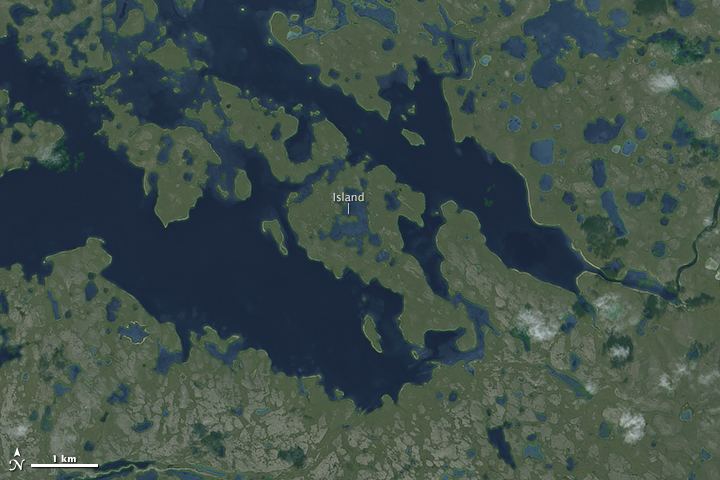 | ||
A lake island is any landmass within a lake. It is a type of inland island. Lake islands may form a lake archipelago.
Contents
- Formation
- Volcanic crater and caldera lake islands
- Impact crater islands
- Floating islands
- Artificial islands
- Naturally occurring lake islands by area
- Other lake islands larger than 80 km
- Islands within lakes recursively
- Notable island systems and former lake islands
- References
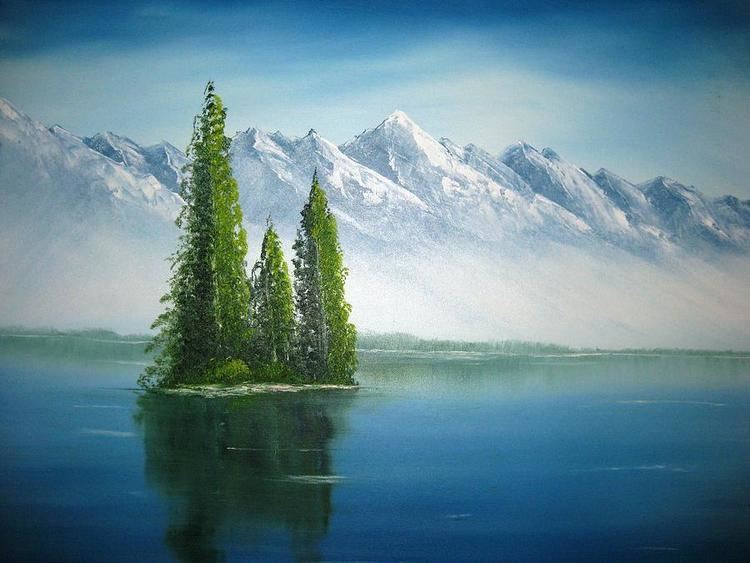
Formation
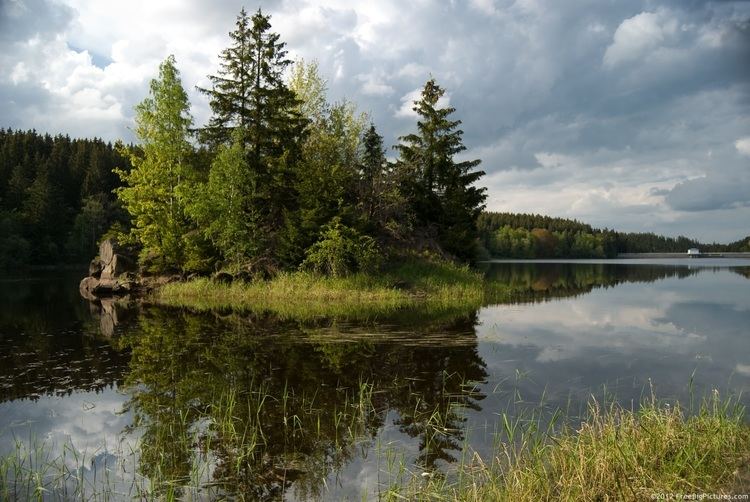
Lake islands may form in numerous ways. They may occur through a build-up of sedimentation as shoals, and become true islands through changes in the level of the lake. They may have been originally part of the lake's shore, and been separated from it by erosion, or they may have been left as pinnacles when the lake formed through a raising in the level of a river or other waterway (either naturally, or artificially through the damming of a river or lake). They may also have formed through earthquake, meteor, or volcanic activity. In the latter case, crater or caldera islands exist, with new volcanic prominences in lakes formed in the craters of larger volcanoes. Other lake islands include ephemeral beds of floating vegetation, and islands artificially formed by human activity.
Volcanic crater and caldera lake islands
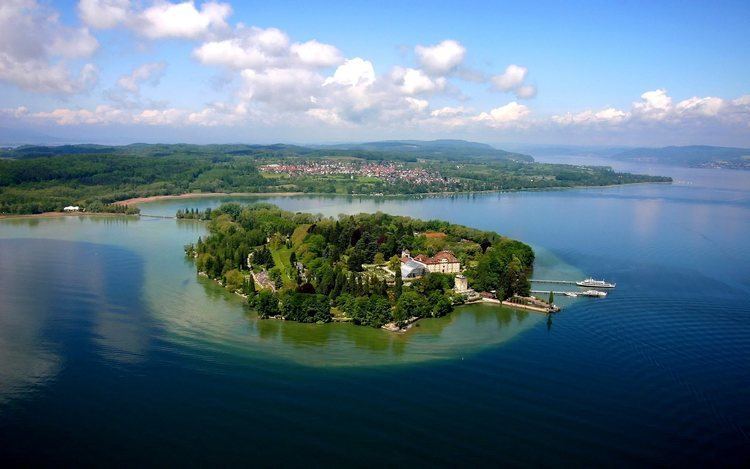
Lakes may sometimes form in the circular depressions of volcanic craters. These craters are typically circular or oval basins around the vent or vents from which magma erupts. A large volcanic eruption sometimes results in the formation of a caldera, caused by the collapse of the magma chamber under the volcano. If enough magma is ejected, the emptied chamber is unable to support the weight of the volcano, and a roughly circular fracture, the ring fault, develops around the edge of the chamber. The centre of the volcano within the ring fracture collapses, creating a ring-shaped depression. Long after the eruption, this caldera may fill with water to become a lake. If volcanic activity continues or restarts, the centre of the caldera may be uplifted in the form of a resurgent dome, to become a crater lake island. Though typically calderas are larger and deeper than craters and form in different ways, a distinction between the two is often ignored in non-technical circumstances and the term crater lake is widely used for the lakes formed in both craters and calderas. The following is a list of large or notable crater lake islands:

Impact crater islands
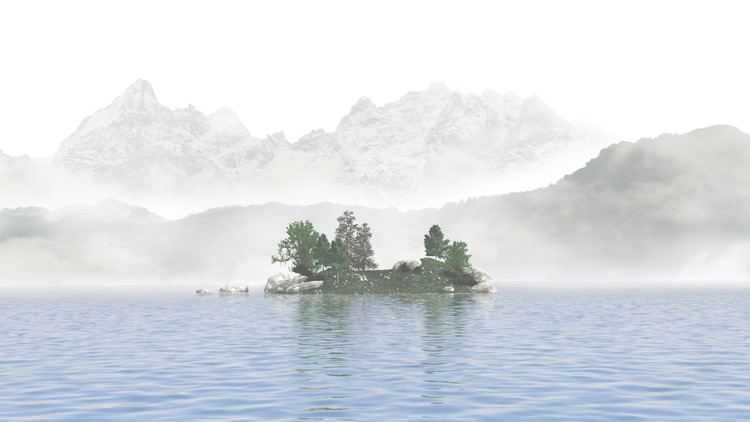
Impact craters, formed by the collision of large meteorites or comets with the Earth, are relatively uncommon, and those which do exist are frequently heavily eroded or deeply buried. Several, however, do contain lakes. Where the impact crater is complex, a central peak emerges from the floor of the crater. If a lake is present, this central peak may break the water's surface as an island. In other cases, other geological processes may have caused only a ring-shaped annular lake to remain from an impact, with a large central island taking up the remaining area of the crater. The world's largest impact crater island (and the world's second-largest lake island of any kind) is René-Levasseur Island, in Lake Manicouagan, Canada. The Sanshan Islands of Lake Tai, China, are also examples of impact crater islands, as are the islands in Canada's Clearwater Lakes, and the Slate Islands of Lake Superior, also in Canada. Sollerön Island in Siljan Lake, Sweden, and an unnamed island in Lake Karakul, Tajikistan, was also formed by meteor impact.
Floating islands
The term floating island is sometimes used for accumulations of vegetation free-floating within a body of water. Due to the lack of currents and tides, these are more frequently found in lakes than in rivers or the open sea. Peaty masses of vegetable matter from shallow lake floors may rise due to the accumulation of gases during decomposition, and will often float for a considerable time, becoming ephemeral islands until the gas has dissipated enough for the vegetation to return to the lake floor.
Artificial islands
Artificial or man-made islands are islands constructed by human activity rather than formed by natural means. They may be totally created by humans, enlarged from existing islands or reefs, formed by joining small existing islands, or cut from a mainland (for example, by cutting through the isthmus of a peninsula). Artificial islands have a long history, dating back to the crannogs of prehistoric Britain and Ireland, and the traditional floating Uru islands of Lake Titicaca in South America. Notable early artificial islands include the Aztec city of Tenochtitlan, at the site of modern Mexico City. Though technically caused by human activity, islands formed from hilltops by the deliberate flooding of valleys (such as in the creation of hydroelectricity projects and reservoirs) are not normally regarded as artificial islands.
Artificial islands are built for numerous uses, ranging from flood protection to immigration or quarantine stations. Other uses for reclaimed artificial islands include expansion of living space or transportation centres in densely populated regions. Agricultural land has also been developed through reclamation of polders in the Netherlands and other low lying countries.
Notable modern examples of artificial lake islands include the Dutch polder of Flevoland, the island of IJburg in Amsterdam, and Flamingo Island in Kamfers Dam, South Africa. At 948 km2 (366 sq mi), Flevoland, in the now-freshwater lake IJsselmeer, is the largest man-made island in the world.
Naturally occurring lake islands, by area
- Manitoulin Island in Lake Huron, Canada - 2,766 km2 (1,068 sq mi)
- René-Levasseur Island in the Manicouagan Reservoir, Quebec, Canada - 2,000 km2 (770 sq mi). It became an artificial island when the Manicouagan Reservoir was flooded in 1970, merging Mouchalagane Lake on the western side and Manicouagan Lake on the eastern side.
- Soisalo between the lakes Kallavesi, Suvasvesi, Kermajärvi, Ruokovesi, Haukivesi and Unnukka, Finland - 1,638 km2 (632 sq mi). Some consider that Soisalo is not a real island because the lakes surrounding it are not on the same level. The greatest difference between the surrounding lakes is 6 m.
- Olkhon in Lake Baikal, Russia - 730 km2 (280 sq mi)
- Isle Royale in Lake Superior, United States - 541 km2 (209 sq mi)
- Ukerewe Island in Lake Victoria, Tanzania - 530 km2 (200 sq mi)
- St. Joseph Island in Lake Huron, Canada - 365 km2 (141 sq mi)
- Drummond Island in Lake Huron, United States - 347 km2 (134 sq mi)
- Idjwi in Lake Kivu, Democratic Republic of the Congo - 285 km2 (110 sq mi)
- Ometepe Island in Lake Nicaragua, Nicaragua - 276 km2 (107 sq mi)
- Bugala Island in Lake Victoria, Uganda - 275 km2 (106 sq mi)
- St Ignace Island in Lake Superior, Canada - 274 km2 (106 sq mi)
Note: Samosir in Lake Toba, Indonesia - 630 km2 (240 sq mi), was originally formed as an island; its current island status, however, is only through its deliberate separation from the mainland by a canal. For this reason, it is not included in the above list.
